Dive into the vibrant world of Laos cuisine, where fiery chilies, fragrant herbs, and bold flavors create unforgettable dishes. From the iconic Laap to the surprising Paeng Pet, this Laos travel guide for 2025 unveils 10 must-try Lao dishes that will tantalize your taste buds and enrich your culinary journey.
Laos, a tranquil gem in Southeast Asia, is a paradise for food lovers, offering a cuisine that’s as vibrant as its lush landscapes. Lao dishes are a symphony of fresh herbs, fiery chilies, and umami-rich ingredients, blending Theravada Buddhist traditions with the country’s 49 ethnic groups’ culinary heritage. From the bustling markets of Luang Prabang to the street stalls of Vientiane, Laos cuisine is gaining global acclaim yet remains full of hidden gems. Whether you’re savoring a bowl of Khao Piak Sen at dawn or tackling the spicy depths of Paeng Pet, these Laotian traditional foods promise a thrilling adventure for your palate. Here are 10 must-try Lao dishes you’ve probably never heard of, each a testament to Laos culinary heritage. Whenever you have a tour to Indochina, do not forget to give it a try!
Laap – The Signature Dish of Laos Cuisine
Laap, often spelled larb or laab, is the cornerstone of Laos cuisine, a minced meat salad that’s a staple across the country. Unlike its Thai counterpart, Laap Laos is heavier on fresh herbs like mint, cilantro, and green onions, with a distinctive nutty crunch from toasted sticky rice powder. According to the Traditional Arts and Ethnology Centre (TAEC), Laap refers to meat prepared fresh after butchering, often served raw (suk) or lightly cooked, with options like pork, fish, or chicken. The dish is seasoned with fish sauce, lime juice, and sometimes bile for a bitter edge, creating a bold, herbaceous flavor.
In rural Laos, Laap is a communal dish, shared with sticky rice and paired with fiery Jaew dipping sauce. Its versatility—raw or cooked, mild or spicy—makes it a must-try for any foodie exploring Laos food culture.
Travel Tip: Savor exceptional Laap at Pa Kam Tan in Vientiane or Xiengtong Restaurant in Luang Prabang (~$3–5). Specify your meat and spice level when ordering to experience this iconic Lao dish.
Paeng Pet – A Daring Laos Culinary Adventure
Paeng Pet is a bold testament to Laos culinary heritage, featuring fresh duck blood mixed with minced duck meat and organs. This dish, packed with herbs like mint, cilantro, and green onions, is a fiery explosion of flavor, balanced by lime juice, crispy shallots, and peanuts. As noted by cultural sources, eating raw blood—duck, pig, or goat—is common in Laos, reflecting the nose-to-tail ethos of Laotian traditional food. The creamy blood contrasts with the rich, oily duck, while raw chilies deliver a searing kick.
Served with sticky rice and shrimp paste-coated chilies, Paeng Pet is a dish for adventurous eaters, offering a unique blend of textures and heat that lingers on the palate.
Travel Tip: Try Paeng Pet at Anna Grilled Duck Restaurant in Vientiane (~$4–6). Visit during the dry season (November–April) for the freshest ingredients and pair with a cold Beerlao to cool the spice.
Jaew – The Fiery Heart of Laos Food Culture
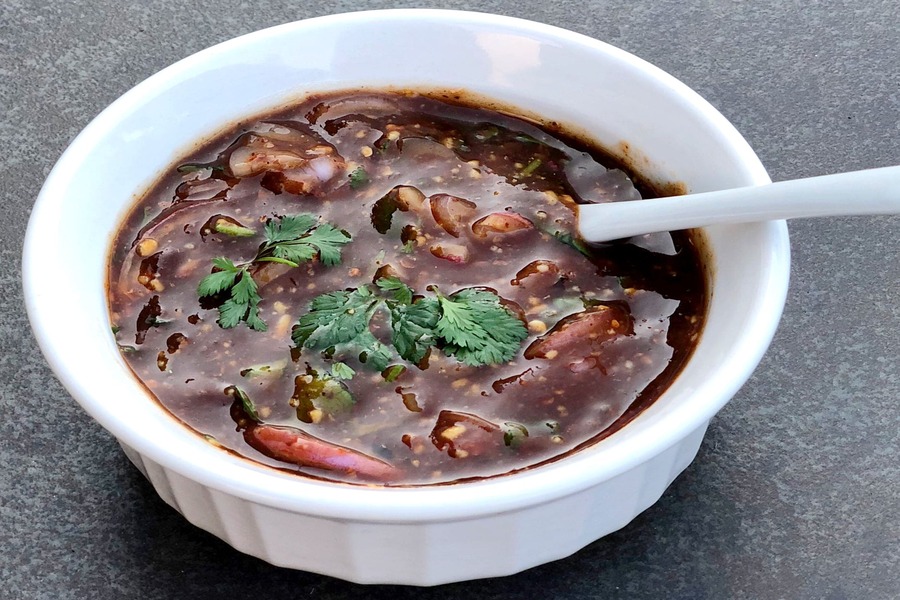
Jaew, a category of dipping sauces, is the soul of Laos cuisine, adding smoky, spicy depth to every meal. Made with a mortar and pestle, Jaew combines roasted chilies, garlic, and often Pa Daek (fermented fish sauce) for intense umami. Variants include Jaew Ma-Keua (roasted eggplant), Jaew Moo (pork and cracklings), and Jaew Bong (dried chilies and buffalo jerky), each with a distinct flavor profile. According to Tourism Laos, the pounding action and grilled vegetables give Jaew its signature smoky taste, perfect with sticky rice or fresh vegetables.
This versatile condiment is a staple at every Lao table, elevating simple ingredients into a flavor-packed experience.
Travel Tip: Find authentic Jaew at roadside stalls near Phou Si Market in Luang Prabang (~$1–2). Ask for a milder version if you’re sensitive to spice, and dip with sticky rice for a true Laos food culture experience.
Or Lam – A Hearty Stew of Laos Culinary Heritage
Or Lam, a thick, earthy stew, is a beloved Laotian traditional food, especially in Luang Prabang. Made with pork fat, buffalo skin, and Mai Sakaan (spicy chili wood), this dish is a nutrient-rich blend of dill, holy basil, and slow-stewed pork parts. The fibrous Mai Sakaan adds a tingling, Sichuan pepper-like sensation, meant to be chewed and spat out. As noted by the Lao Handicraft Association, the stew’s sticky texture and robust flavors make it a comforting staple, often served with sticky rice.
Its unique ingredients and long cooking time create a dish that’s both hearty and deeply satisfying.
Travel Tip: Enjoy Or Lam at Phamsai Houngchalern Restaurant in Luang Prabang (~$3–5). Visit in the cooler months (November–February) for a warming meal and pair with sticky rice to soak up the broth.
Khao Piak Sen – The Comforting Laos Street Food
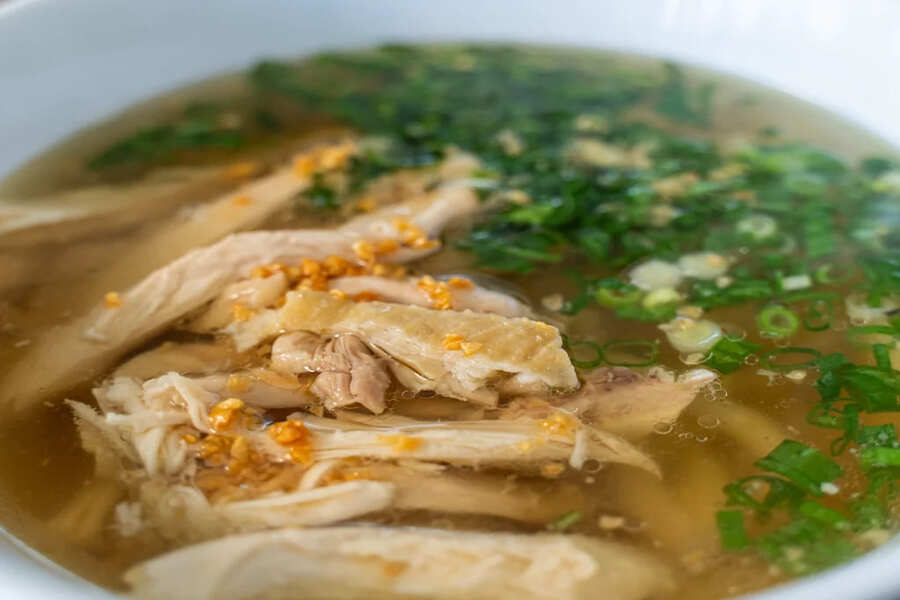
Khao Piak Sen, a rice noodle soup, is a morning ritual across Laos, embodying the simplicity and depth of Laos street food. Unlike typical noodle soups, its hand-rolled, starchy noodles create a thick, gravy-like broth, made from a slow-simmered meat stock (pork or chicken). Topped with fresh herbs, fried red chilies, shrimp paste, and crushed peanuts, it’s a dish that warms the soul. Cultural sources trace its origins thousands of years to rice-based versions like Khao Piak Kao, highlighting its enduring place in Laos food culture.
Found at street corners and markets, Khao Piak Sen is a must for breakfast or a quick lunch.
Travel Tip: Seek out Khao Piak Sen at the Morning Market in Luang Prabang (~$1–2). Look for stalls with large stainless steel pots and long lines for the freshest bowls, and add lime for extra zest.
Tam Mak Hoong – The Staple of Laos Cuisine
Tam Mak Hoong, a green papaya salad, is the heartbeat of Laos cuisine, served with sticky rice at nearly every meal. Made by pounding unripe papaya, chilies, Pa Daek, lime juice, and tomatoes in a mortar, this dish is a fiery, umami-packed delight. Variants like Tam Mak Kluay (green banana) or Tam Mak Muang (mango) showcase the versatility of Tam, with each ingredient amplifying the others’ flavors. According to golaos.tours, the pounding action—Tam—defines the dish, releasing intense aromas and textures.
Its balance of sour, spicy, and savory makes it a daily essential for Laotians.
Travel Tip: Order Tam Mak Hoong at Som Tam Luang Prabang in Vientiane (~$2–3). Specify “pet nit noi” for less spice, and pair with sticky rice for an authentic Laotian traditional food experience.
Khao Jee Pa-Tay – A French-Inspired Laos Street Food
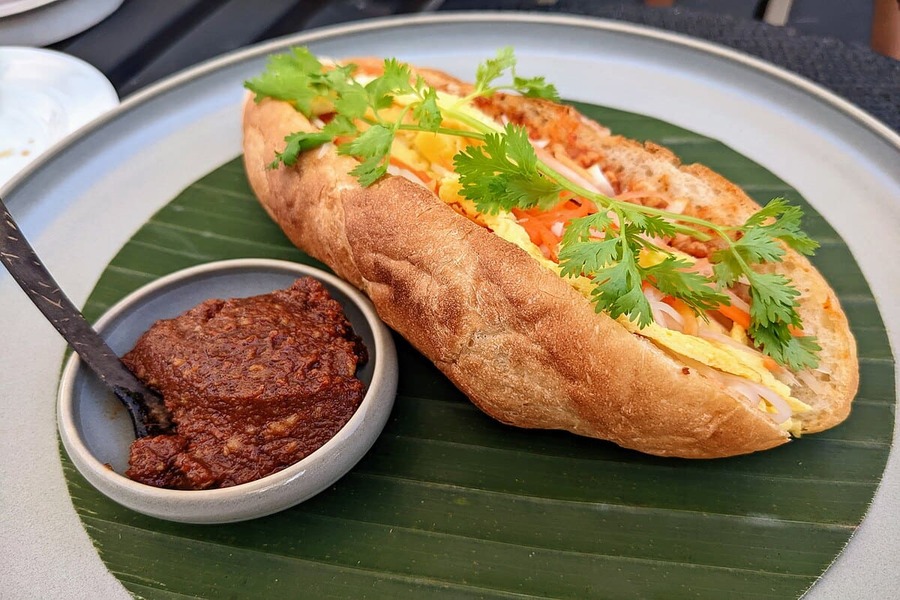
Khao Jee Pa-Tay, Laos’ answer to the banh mi, is a fusion of Laos culinary heritage and French colonial influence. This baguette sandwich is stuffed with rich pork pate, pork sausage, pickled carrots, cucumbers, green onions, and a sweet-spicy red sauce, often topped with pork floss. As noted by cultural sources, the chaotic assembly at Vientiane’s bus stations—where vendors toss ingredients with flair—adds to the experience. The pate’s livery depth anchors the vibrant vegetables, creating a handheld masterpiece.
Affordable and ubiquitous, Khao Jee Pa-Tay is a perfect on-the-go meal.
Travel Tip: Grab a Khao Jee Pa-Tay opposite Phonsavanh Bank in Savannakhet or at Khao Gee Mae Sab Restaurant in Vientiane (~$0.50–$2). Order the “full option” with steak for maximum flavor.
Sai Oo-ah – The Ultimate Laos Sausage Dish
Sai Oo-ah, a grilled pork sausage, is a standout in Laos street food, bursting with flavor in every bite. Made with pork belly, skin, and minced meat, it’s packed with dill, cilantro, galangal, green onions, and fresh chilies, creating a juicy, herbaceous sausage with a smoky aroma. According to Tourism Laos, the high herb content sets Sai Oo-ah apart globally, making it a must-try for meat lovers. Grilled over charcoal, it’s often served with sticky rice or wrapped in banana leaves for takeout.
Its perfect balance of fat, spice, and herbs makes it irresistible.
Travel Tip: Find Sai Oo-ah at street grills across Luang Prabang or Vientiane (~$1–2). Order extra in a banana leaf packet to enjoy later, and pair with Jaew for a fiery kick.
Mok Pa – A Mysterious Laos Culinary Delight
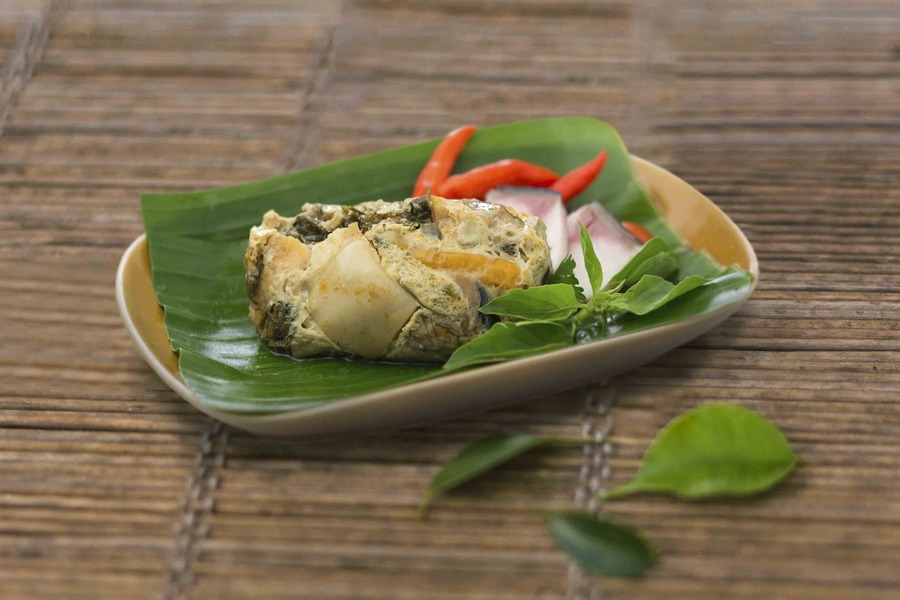
Mok, a banana or taro leaf-wrapped parcel, is a versatile Lao dish cooked by steaming or roasting over coals. Common fillings include fish, pork, herbs, or even pig brains (Mok Samong), with bamboo shoots (Mok Naw Mai) offering a vegetarian option. As noted by the Lao Handicraft Association, the unpredictability of Mok—sometimes marked by toothpick placement—adds excitement, with each unwrap revealing a new flavor. The steaming process locks in aromas, creating a warm, gooey texture.
Served with sticky rice, Mok is a delightful surprise at any meal.
Travel Tip: Explore Mok at Phou Si Fresh Market in Luang Prabang (~$1–3). Try multiple varieties to discover your favorite, and look for Mok Naw Mai for a vegetarian-friendly Laotian traditional food.
Naem Khao – A Fermented Laos Food Specialty
Nam Khao, a fermented pork delicacy, is a morning market treasure in Laos cuisine, known for its sour, chewy goodness. Made with pork skin, cartilage, and minced meat, it’s steamed, then sun-dried for 1–2 days, developing a tangy flavor. Spiked with chilies and collagen-rich, Nam Khao exemplifies Laos’ nose-to-tail approach, using every part of the animal. Cultural sources highlight its efficiency and bold taste, making it a unique addition to Laos street food.
Its mushy texture and spicy heat are perfect with sticky rice or as a snack.
Travel Tip: Seek out Nam Khao at the Night Market near Luang Prabang’s Walking Street (~$1–2). Pair with sticky rice and Jaew to balance the sourness, and enjoy as a quick market bite.
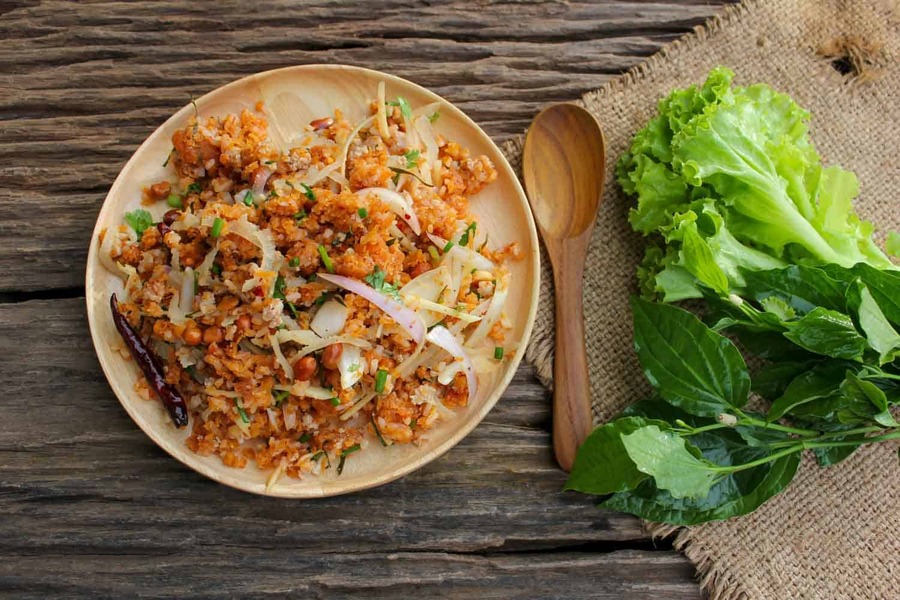
Discovering Laos Culinary Heritage
These 10 must-try Lao dishes are just the beginning of Laos cuisine’s vibrant world, where fresh herbs, fiery chilies, and nose-to-tail ingredients create unforgettable flavors. From the herbaceous Laap to the daring Paeng Pet, each dish reflects the ingenuity and diversity of Laos culinary heritage. For travelers in 2025, exploring Laos food culture in Luang Prabang, Vientiane, or Savannakhet is a culinary adventure, with markets and street stalls offering authentic experiences.
Visit during the dry season (November–April) for the freshest ingredients and vibrant festivals like Pi Mai, where food plays a central role. Respect local customs by asking before photographing vendors and supporting small businesses. Costs are affordable—most dishes range from $1–$6, with market finds as low as $0.50. For a deeper dive, join a cooking class at Tamarind Restaurant in Luang Prabang (~$30) to learn recipes like Tam Mak Hoong or Mok.
Pro Tip: Start your food journey at Luang Prabang’s Morning Market, then explore Vientiane’s bus station for Khao Jee Pa-Tay. Combine with cultural visits to Wat Xieng Thong or Kuang Si Waterfall for a complete Laos travel guide 2025 experience.
By savoring these Lao dishes, you’ll uncover the heart of Laos, where every bite tells a story of tradition and flavor.

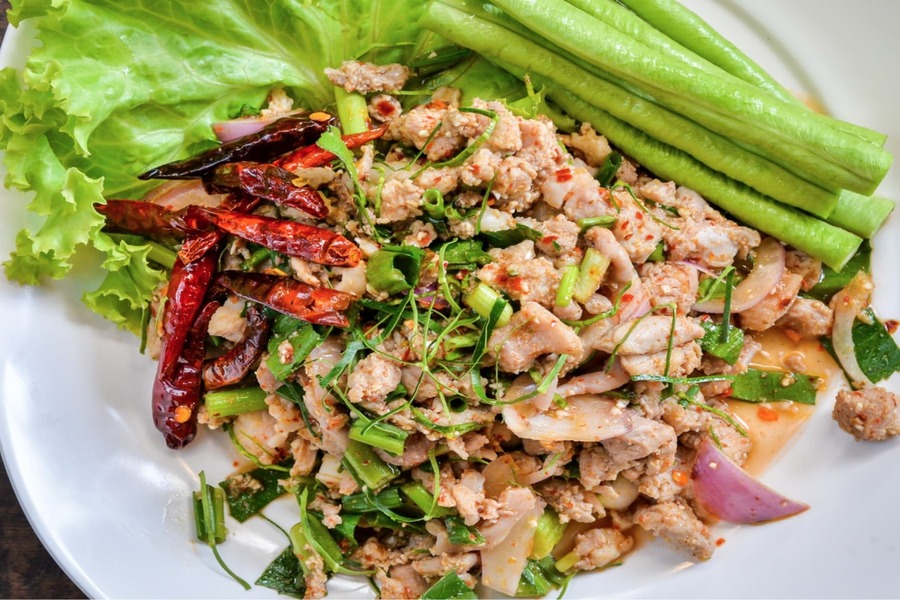
0 Comment